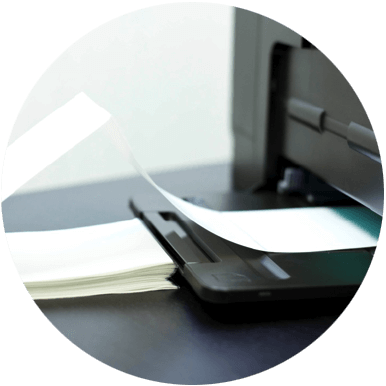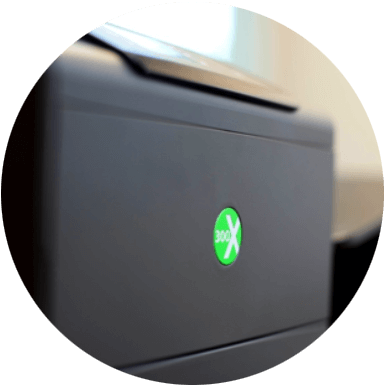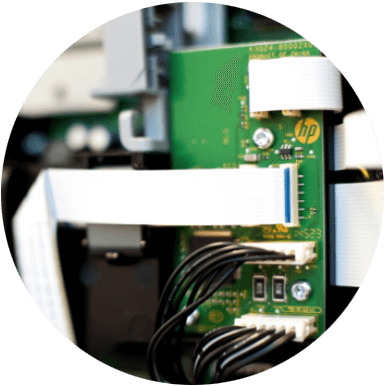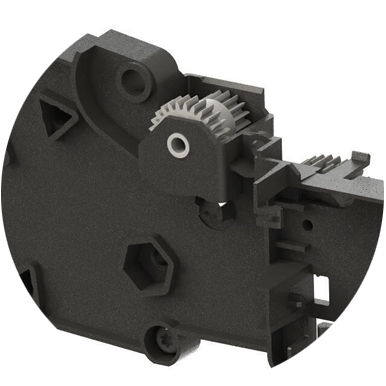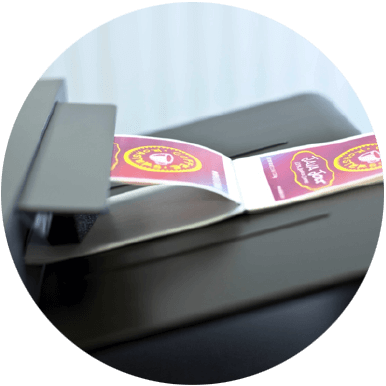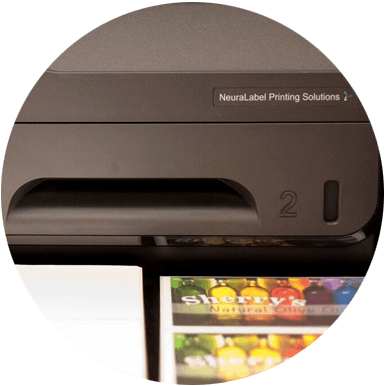Case Study: NeuraLabel 300X On-Demand Label Printer
The Quality and speed of HP's record-setting page-wide array technology transforms the label market.
Every once in a while a product comes along that changes an entire industry. With the advent of HP’s page-wide inkjet technology, they released a product that shattered the Guinness World Record book for inkjet printer speed. That same technology is the secret behind the Neuralabel 300X, which is revolutionizing the label industry with the first desktop inkjet label printer to print full-color, high-resolution 8.5 inch wide labels at 100 feet per minute.
In the past, small business basically had two choices: 1. mail-order a set amount of labels, which leads to unused inventory and the delay of shipping, or 2. use slow desktop label printers. Now they are able to get bright, beautiful labels two to three times faster than traditional desktop label printers, and only print the exact quantity they need.
Simplexity was chosen as the engineering partner to develop the Neuralabel 300X due to our decades of experience with HP technology and our key role in designing the original page-wide array office printer.
What We Did
We followed our 7 Steps to Simplification© process which reduces risk and leads to simpler designs.
1. Ask Questions
Before starting any engagement, we ask questions that uncover the latent needs that then drive the product requirements. The biggest challenge for the project was to successfully switch from a cut-sheet printer to a continuous media feed printer. Some of the key questions we asked include:
- How will we register the top of sheet on continuous media with the HP print engine?
- How can we manage continuous printing while maintaining sheet to sheet registration on a Z-fold stack? The Nth page on each print out must align to each other on the Z-fold stack.
- How will we manage servicing without a gap in the media for spitting?
- How do we manage possible media feed skew?
- What is the best strategy for managing cumulative media feed error?
In addition to the technical questions, we asked the business questions of how big the market was and sales projections so we could design the right product for the market need.
2. Write Down the Specs
One interesting aspect of this product is that the initial specifications were for a well log printer. A well log printer is used in the oil and gas industry to literally log every foot of a well that has been drilled in a paper record. This project was a great example of how specifications evolve over time and market needs. Some of the initial specifications, like having to print on 1,000 feet of continuous media, changing the pen servicing since there is no break between pages, were the same for both the well log and label printing products. However, when adding the requirements of printing on label media, the specifications evolved to decrease the minimum print size (some labels are very small!) and have the ability to print on a wider variety of media. A written specification allows all members of the team, from marketing to engineering have a clear sense of what is being built and the capabilities that can be met.
3. Brainstorm From A Systems Perspective
In determining the system architecture of the new continuous media printer, our process is to brainstorm ways of achieving the results while making the simplest changes. This often means looking at problems from a system perspective rather than through only one of the engineering disciplines (i.e. mechanical). One of the challenges was how to service the print head to keep print quality high. The standard HP product spits ink between pages to keep the inkjet nozzles clean, something that is not possible with continuous media. Rather than making complex mechanical changes, we decided to heavily modify the servicing routines in firmware allowing for it to service on the media. This led to other challenges like how to prevent ink pooling, which was elegantly solved by moving the media during servicing and minimizing waste.
Another challenge solved from a systems perspective was the significant increase in duty cycle. The power supply in the original printer had been chosen based on assumption of a low duty cycle. Since the power supply is internal to the product, switching it out with a larger one would have caused significant design changes. Rather, we worked with HP engineers to make the original supply work by figuring out a way to dynamically reduce the power usage to print as fast as possible while preventing overheating. HP even chose to file a patent on this innovation.
4. Design With The End In Mind
The detailed design of a product should be done while considering how it will be manufactured, tested, serviced, and used. For example, knowing that print jobs would be much larger than for general office printing, we double the RAM in the printer. Now 39 inch long labels can be printed in normal mode and the best mode label length has been increased from 14 inches in the original product to 22 inches.
During the detailed design phase we also added a PCA to:
- Modify the top-of-form paper sensor behavior so we could detect marks printed on the back side of the label.
- Monitor the current going to the print head to allow for continuous print head health checking instead of checking between pages, as the original product did.
Anticipating the needs of the end user, we added the following new functionality:
- Added jogging/form feed capability that would facilitate loading and unloading of media.
- Added a printing slow-start capability to allow the user to easily feed roll media onto an output spool at a low speed of 2 inches/sec before going to full speed.
- Added SNMP (simple network management protocol) OIDs (object identifiers) to enable more printer state reporting to the end users. This includes reports like when ink is running out or number of pages printed successfully on the last job.
- Added a data buffering mode that allows the printer to work over an intermittent network connection, preventing buffer underruns or data starvation. For example if the network drops out for a few seconds, the printer does not fail the whole job. Instead it just slows down until network connection is back up again and uses the extra RAM to store the data. Other printers require a separate hard drive to do this, but the Neuralabel 300X can print jobs that are 2-3 GB in size, which saves on the total cost of ownership.
- Added custom printer reports for continuous jobs so field service technicians can get a status report on the health of printer.
5. Do The Math
When converting a product from one set of specifications (low-duty intermittent printing) to another set (high-duty continuous printing), it is critical to run the engineering calculations to make sure that the parts will hold up to the new requirements.
In converting the OfficeJet ProX to the Neuralabel 300, two problem areas were uncovered:
- By running PV (pressure-velocity) calculations on the gears, we concluded that the plastic material in certain gears simply could not hold up to the rigors of continuous printing. The best solution was to mold the gears in a more durable plastic. This design change was confirmed via testing which affirmed that the original gears would start to melt, whereas the new gears were able to withstand the high-duty use cycle without issues.
- We noticed that the output motor was overloaded. We found the cause by running a tolerance analysis on the parts in that area. Root cause was determined to be that the spring on the output drive was specified with too wide a mechanical tolerance. Initial parts that were close to nominal dimensions would work fine, but any parts on the outer band of the tolerance range would cause problems in the new high-duty application. This was fixed with a change to the specification drawing.
6. Prototype And Test
Prototyping and testing is critical to ensure product quality, especially at high volumes. As noted above, one of the changes that had been made to the printer was to detect registration marks on the back side of the media. This was accomplished through using the existing reflective photo-detector sensor in a different operating regime when it detects that paper is present. In order to guarantee the correct angle between the sensor and the paper, ribs in the plastic part holding the paper needed to be modified to change the media buckling behavior. A series of prototyping and testing iterations were conducted to find the optimal rib height and location to meet the mark detection reliability criteria.
7. Select Proven Manufacturers
In order to minimize risk, the same contract manufacturer who built the original page-wide array office printer was selected to build the Neuralabel 300X. Simplexity engineers travelled to the manufacturer site in Asia for the first three builds to help ensure product quality and manufacturing line capability for the new features. By having our engineers on the manufacturing floor, we were able to quickly find and debug problems such as:
- One of the molds had extra flashing that was causing increased friction which caused duplex motor overheating.
- A screw that was over-tightened that would cause too much loading on a gear.
Our engineers were also able to address a fundamental problem of continuous media, which is image stretch due to drag (paper stretches by about 0.3%). In order to adjust for this error, we took an existing test from the production line and modified it to measure the amount of stretch on the paper itself. Then each printer is calibrated on the production line for the media, and the calibration data is stored back to the individual unit.
The contract manufacturer did an excellent job quickly implementing the changes Simplexity engineers suggested, which led to a reliable and robust product.
“(Simplexity has) the kind of engineers that you want, (the ones) that are looking for the simplest solution. The simplest solution is almost always the best solution. We …view Simplexity as our secret weapon.”
-Ken Land
President and CTO, NEURALABEL
Making A Difference
Owning a Neuralabel 300X allows businesses to print labels for food, cosmetics, bottles, medical devices, pharmaceuticals, and even chemical containers (since the labels are GHS compliant). Printed with water-resistant HP pigment inks, the labels are durable and can be printed on a wide variety of media. Business owners have a lot to worry about in the day-to-day running of their business; getting the right labels for their products should not be one of them. With a price point of under $5K, it’s no wonder that the Neuralabel 300X was selected as Occupational Health & Safety’s 2015 Product of the Year. Please visit Neuralabel’s website for more information or to request a quote.


